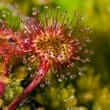Background
- Drosera species are carnivorous plants that use their hairs to trap, immobilize, and digest insects. Preying on insects is their primary means of obtaining nutrients. Drosera species have reportedly been used medicinally at least since the 12th Century in Europe when an Italian doctor named Matthaeus Platearius described the plants as a cough remedy. Generally, Drosera is used for lower respiratory tract conditions, such as bronchitis, asthma, and coughs.
- These early uses have some current data to support the clinical effectiveness of Drosera for the symptoms of chronic obstructive pulmonary disease (COPD), including shortness of breath, wheezing, cough, sleep disturbances, and disability from chronic illness. Testing individual components of Drosera species has revealed anti-inflammatory, anti-spasmodic, and antibacterial effects. Although there is not a large amount of modern research that documents Drosera's clinical effects, it is a fairly commonly used medicine alone or as part of a combination in roughly 200-300 registered medications.
References
- Didry N, Dubreuil L, Trotin F, et al. Antimicrobial activity of aerial parts of Drosera peltata Smith on oral bacteria. J Ethnopharmacol 1998;60(1):91-96.
View Abstract - Ferreira DT, Andrei CC, Saridakis HO, et al. Antimicrobial activity and chemical investigation of Brazilian Drosera. Mem Inst Oswaldo Cruz 2004;99(7):753-755.
View Abstract - Kamarainen T, Uusitalo J, Jalonen J, et al. Regional and habitat differences in 7-methyljuglone content of Finnish Drosera rotundifolia. Phytochemistry 2003;63(3):309-314.
View Abstract - Kolodziej H, Pertz HH, and Humke A. Main constituents of a commercial Drosera fluid extract and their antagonist activity at muscarinic M3 receptors in guinea-pig ileum. Pharmazie 2002;57(3):201-203.
View Abstract - Krenn L, Beyer G, Pertz HH, et al. In vitro antispasmodic and anti-inflammatory effects of Drosera rotundifolia. Arzneimittelforschung. 2004;54(7):402-405.
View Abstract - Leclercq J. and Angenot L. [Drosera peltata and the standardization of drosera tincture]. J Pharm Belg 1984;39(5):269-274.
View Abstract - Marczak L, Kawiak A, Lojkowska E, et al. Secondary metabolites in in vitro cultured plants of the genus Drosera. Phytochem Anal 2005;16(3):143-149.
View Abstract - Mativandlela SP, Meyer JJ, Hussein AA, et al. Activity against Mycobacterium smegmatis and M. tuberculosis by extract of South African medicinal plants. Phytother Res 2008;22(6):841-845.
View Abstract - Melzig MF, Pertz HH, and Krenn L. Anti-inflammatory and spasmolytic activity of extracts from Droserae herba. Phytomedicine 2001;8(3):225-229.
View Abstract - Murali PM, Rajasekaran S, Paramesh P, et al. Plant-based formulation in the management of chronic obstructive pulmonary disease: a randomized double-blind study. Respir Med 2006;100(1):39-45.
View Abstract - Okabe T, Mori H, and Ohyama T. Deoxyribonuclease secreted from an insectivorous plant Drosera adelae. Nucleic Acids Symp Ser 1997;(37):127-128.
View Abstract - Paper DH, Karall E, Kremser M, et al. Comparison of the antiinflammatory effects of Drosera rotundifolia and Drosera madagascariensis in the HET-CAM assay. Phytother Res 2005;19(4):323-326.
View Abstract - Plachno BJ, Adamec L, Lichtscheidl IK, et al. Fluorescence labelling of phosphatase activity in digestive glands of carnivorous plants. Plant Biol (Stuttg) 2006;8(6):813-820.
View Abstract - Krolicka A, Szpitter A, Maciag M, et al. Antibacterial and antioxidant activity of the secondary metabolites from in vitro cultures of Drosera aliciae. Biotechnol Appl Biochem 9-9-2008;
View Abstract - Wang Q, Shu J, and Zeng L. [Chemical constituents of Drosera peltata Smith var. lunata (Buch.-Ham.) C.B. clarke collected in Tibet]. Zhongguo Zhong Yao Za Zhi 1998;23(11):683-4, 704.
View Abstract







